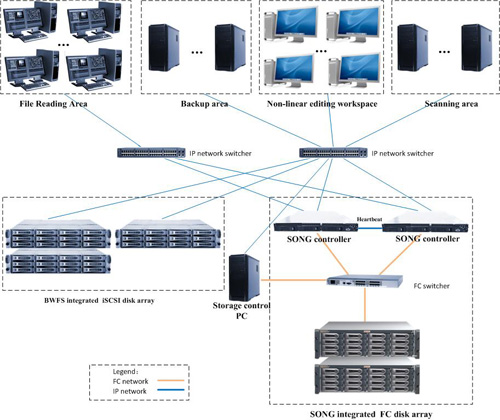Company
An archive in Nanjing
Project background:
The archive is responsible for receiving, collecting and keeping archives as well as sharing its information with the public. The archive comprises the reading and storage, non-editing, scanning and backup zones and has strict requirements on the safety of statistics. Man-made operation mistakes, network failures, power failure or fire in the equipment room and hardware damage may interrupt the business or cause data losses, leading to great losses to the core business of the archive. Currently, the archive runs its multiple business systems separately, resulting in information isolation and huge waste of the system resources. Moreover, the existing storage system cannot meet current and future needs of its business development. Data cannot be shared conveniently under a heterogeneous operating system environment.
Project demands:
The business system of the archive's storage zone has a moderate requirement on the performance of the storage device. The business mainly includes data read. The non-editing zone is mainly responsible for HD non-linear editing, which includes data read/write services. The HD non-editing system has a high requirement on the bandwidth and delay. The scanning and backup zones are responsible for data processing, which focuses on data writing, requiring a considerable bandwidth. To ensure the data safety of the reading and non-editing zones, data must be copied into the storage devices in the backup zone for mid- and long-term storage.
Solution:
The project adopts a set of BlueWhale Scale-out NAS Gateway (SONG) integrated FC disk array storage and BlueWhale File System (BWFS) integrated iSCSI disk array, providing business systems of the archive with a data access channel that underpins data sharing and features large bandwidth, high concurrency and low delay. The reading and non-editing zones adopt the SONG storage device that integrates SATA and SAS hard disks. The reading zone adopts the 2 TB SATA hard disks, while the non-editing zone adopts 600 GB SAS hard disks, which provide a high data read/write speed. The scanning and backup zones are configured with the iSCSI array storage device. The storage space is allocated according to demands of each business system. To ensure safety of data, a storage and backup server is adopted to copy data in the SONG storage device into the BWFS storage device regularly based on the backup strategy designed by the user.
The SONG system provides interfaces for data sharing on a heterogeneous platform and standard network file access protocols on the client such as NFS, CIFS and FTP. Adopting the open scale-out structure, the file processing and data storage modules of the storage system provide a large storage capacity, which can be expanded up to 16 PBs, while providing a large bandwidth and high reliability.

Application effect:
Devices of different series are adopted for different business systems, thus establishing the optimal storage system for the customer:
1. Demand-based allocation of storage space: The BWFS and SONG storage devices can store data separately and manage data in a centralized manner, improving data reliability and safety, simplifying the data processing process, reducing data redundancy and simplifying management.
2. Cross-platform data sharing: The storage system realizes data sharing in a heterogeneous operating system environment, supporting operating systems including Windows, Linux and Mac.
3. High-speed data transmission: The SONG is comparable to two NAS nodes in terms of the storage capacity. Each NAS node offers four GE interfaces, providing a large I/O bandwidth. Through BWFS Client and the SAN FS mode, the application server can access the iSCSI storage system and fully take advantage of the performance of the high-concurrency client.
4. High availability: The SONG storage system adopts the open scale-out structure. As the requirement of the project for the computing capacity increases in the future, the user can dynamically add NAS gateway nodes to expand the output bandwidth in a linear manner to meet future business needs. The project adopts two NAS node devices. Therefore, when one NAS gateway fails, the other one can automatic take over the data IO and realize HA, eliminating the risk of business interruption due to the single node of traditional NAS.
5. Online expansion of storage capacity: BWFS and SONG storage devices support online expansion of storage capacity. When the storage capacity falls short of the need, the administrator can add network storage devices transparently to expand the storage capacity.
6. Centralized monitoring and management: The solution provides a Web interface to realize centralized management of the storage system and clients, enabling the user to operate, configure and view the system all on one management interface. The interface also provides historical analysis report, performance monitoring and failure analysis.